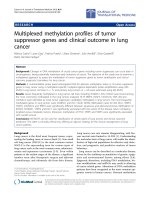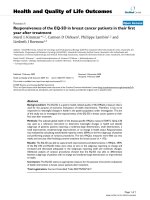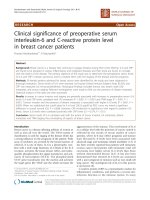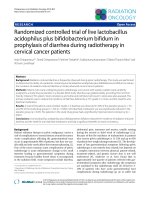Outcomes of immediate oncoplastic surgery and adjuvant radiotherapy in breast cancer patients
Bạn đang xem bản rút gọn của tài liệu. Xem và tải ngay bản đầy đủ của tài liệu tại đây (878.3 KB, 8 trang )
Borm et al. BMC Cancer
(2019) 19:907
/>
RESEARCH ARTICLE
Open Access
Outcomes of immediate oncoplastic
surgery and adjuvant radiotherapy in
breast cancer patients
Kai Joachim Borm1, Christine Schönknecht1, Andrea Nestler1, Markus Oechsner1, Birgit Waschulzik2,
Stephanie Elisabeth Combs1,3,4, Stefan Münch1, Markus Niemeyer5 and Marciana Nona Duma1,6*
Abstract
Background: Oncoplastic surgery techniques lead to a rearrangement of the breast tissue and impede target
definition during adjuvant radiotherapy (RT). The aim of this study was to assess local control rates after immediate
oncoplastic surgery and adjuvant RT.
Methods: This study comprises 965 patients who underwent breast-conserving therapy and adjuvant RT between
01/2000 and 12/2005. 288 patients received immediate oncoplastic surgery (ONC) and 677 patients breast-conserving
surgery only (NONC). All patients were treated with adjuvant external tangential-beam RT (total dose: 50/50.4 Gy;
fraction dose 1.8/2.0 Gy). An additional boost dose of 10–16 Gy to the primary tumor bed was given in 900 cases
(93.3%). Local control rates (LCR), Progression free survival (PFS) and overall survival (OS) were assessed retrospectively
after a median follow-up period of 67 (Q25-Q75: 51–84) months.
Results: No significant difference was found between ONC and NONC in regard to LCR (5-yr: ONC 96.8% vs. NONC
95.3%; p = 0.25). This held also true for PFS (5-yr: ONC 92.1% vs. NONC 89.3%; p = 0.09) and OS (5-yr: ONC 96.0% vs.
NONC 94.8%; p = 0.53). On univariate analyses G2–3 (p = 0.04), a younger age (p = 0.01), T-stage (p < 0.01) lymph node
involvement (p < 0.01) as well as triple negative tumors (p < 0.01) were identified as risk factors for local recurrence. In a
propensity score stratified Cox-regression model no significant impact of oncoplastic surgery on local control rate was
found (HR: 2.05, 95% CI [0.93; 4.51], p = 0.08).
Conclusion: Immediate oncoplastic surgery seems not to affect the effectiveness of adjuvant whole breast RT on local
control rates in breast cancer patients.
Keywords: Local control rate, Oncoplastic surgery, Adjuvant radiotherapy, Boost definition, Breast conserving therapy
Background
Advances in the multimodal therapy of breast cancer
have constantly improved the outcome in last decades.
According to current studies an overall survival (OS) of
over 90% and a local control rate (LCR) of over 95% can
be achieved after 5 years when treatment modalities such
as surgery, radiotherapy (RT) and systemic therapy are
combined [1, 2]. However, most patients suffer from
* Correspondence:
1
Department of Radiation Oncology, Faculty of Medicine, Technical
University Munich (TUM), Medical School, Klinikum rechts der Isar, Ismaninger
Strasse 22, 81675 Munich, Germany
6
Department of Radiation Oncology, University Hospital Jena, Bachstraße 18,
07743 Jena, Germany
Full list of author information is available at the end of the article
cosmetic impairment after surgical resection of the
breast. Wide excision is shown to be a predictive factor
for poor cosmetic results and a decrease of quality of life
[3]. Thus, minimally invasive procedures and surgical
reconstruction techniques are becoming increasingly
important in breast cancer treatment. Surgical reconstruction techniques comprise breast reshaping techniques (e.g. Rotation flaps, reduction mammoplasty)
and volume replacement procedures (latissimus dorsi
flap, transverse rectus abdominis flap, expander) [4].
Due to potential donor site morbidity associated with
volume replacement techniques, volume displacement
techniques are the preferred method for concomitant
reconstructive surgery during breast conservative surgery
© The Author(s). 2019 Open Access This article is distributed under the terms of the Creative Commons Attribution 4.0
International License ( which permits unrestricted use, distribution, and
reproduction in any medium, provided you give appropriate credit to the original author(s) and the source, provide a link to
the Creative Commons license, and indicate if changes were made. The Creative Commons Public Domain Dedication waiver
( applies to the data made available in this article, unless otherwise stated.
Borm et al. BMC Cancer
(2019) 19:907
(BCS) [5]. These techniques lead to a rearrangement of
the breast tissue and increase the anatomical changes
caused by the surgical procedure. There is good evidence that most ipsilateral recurrences occur close to
the site of the primary tumor, and that they arise often
from residual tumor cells in tumor bed [6]. Adjuvant
RT is performed to inactivate these residual tumor cells
and thus to increase local control rates [2]. Immediate
volume displacement procedures after tumor resection
are challenging for radiation oncologists, as these surgical procedures potentially change the site of the primary tumor bed and the definition of the boost target
volume might be impaired.
There is a lack of evidence in literature regarding
the effectiveness of adjuvant RT on local control rates
after breast conserving therapy and immediate volume
displacement techniques. Previous studies addressing
the oncological outcome after immediate breast reshaping neglected important factors related to the RT
treatment [3, 5, 7–9]. Thus, it remains difficult to estimate the impact of reconstruction techniques on the
success of adjuvant RT. This study was performed to
evaluate the oncologic outcome after breast conserving therapy and immediate volume displacement reconstruction in a large patient collective taking RT as
an important factor of local control in breast cancer
into account.
Methods
Patients
This study comprises 965 patients who underwent adjuvant RT between 01/2000 and 12/2005 at the department of radiation oncology, Klinikum rechts der Isar,
Munich. All patients received BCS and had no distant
metastases at the time of diagnosis. Patient with other
malignancies in addition to breast cancer were excluded
from this analysis. In 288 cases immediate oncoplastic
surgery (ONC) was performed of which 265 patients
received a rotation flap and 23 patients reduction mammoplasty. One patient received volume replacement
(thoraco-epigastric flap). The remaining 677 patients
undergoing BCS were assigned to the control group (No
oncoplastic surgery; NONC). Incisions of the rotation
flap include a semi-circular line (usually in the upper
quadrants) and a parallel semicircular arc at the margin
line of the breast. The breast tissue within this area is removed and the bordering skin and subcutaneous tissue
is used as flap and elevated and rotated to fill the defect.
Reduction mammoplasty combines the techniques of
tumorectomy and bilateral breast reduction (Fig. 1a-c).
With both methods, the tumor can be excised with
wider margins [10]. The preoperative design of reduction mammoplasty and rotation flap are presented in
Fig. 1 d and e. No surgical clips were placed in the
Page 2 of 8
tumor bed. Whether a patient was admitted to oncoplastic surgery or conventional breast conserving surgery
was decided in an interdisciplinary approach based on
factors such as tumor location, expected tissue defect as
well as the age and the will of the patient. A total number of 550 patients (57.0%) were given Chemotherapy
before (9.6%) or after (47.4%) the surgery. 741 (76.8%)
patients received anti-hormonal therapy.
Radiotherapy (RT)
All patients were treated with external tangential beam
RT to the breast. Irradiation was delivered using highenergy (6MV) linear accelerators (Megatron KD2 or
MX2, Siemens, Munich, Germany). 725 (75.1%) patients
received a two-dimensional planned RT, 240 (24.9%) of
the patients underwent three-dimensional CT treatment
planning (Fig. 1). Patients were simulated in supine position in treatment position with both arms abducted
overhead. For 2D treatment planning, treatment fields
were arranged by clinical examination of the patient
combined with fluoroscopic 2D simulation. Superior
treatment borders were set 2 cm beyond the palpable
breast and 2 cm inferior the inframammary fold. The
medial and lateral and medial borders were placed at the
midsternal and midaxillary line, respectively. For 3D-CT
based planning the target volume and organs at risk
were contoured according to the RTOG guidelines [11].
All plans (2D- and 3D-plans) consisted of 2 opposing
tangential beams. If necessary, wedges were applied.
During 3D-treatment planning, additional beam segments were used to improve target dose coverage and
homogeneity (Intended dose distribution: PTV Dmax: <
107% of prescribed dose, Dmin > 95% of prescribed
dose). A total dose of 50/50.4 Gy (fraction dose 1.8 Gy or
2.0 Gy) to the whole breast was prescribed. An additional boost dose of 10–16 Gy to the primary tumor bed
was given in 900 cases (93.3%). The mean size of the
boost was 51.6 ± 28.5 cm2. The boost was applied percutaneously with a linear accelerator as direct field with
electrons or 3D planned with photons (electron boost:
n = 873, photon boost n = 17, not applicable n = 73). The
location of the tumor bed was estimated based on mammography images and tissue scars. In 98 cases, the
supraclavicular lymph node levels were part of the target
volume with a median prescribed dose of 46 Gy (45–60
Gy). The mean time interval between BCS and postoperative RT was 91.1 ± 63.8 days.
Follow-up and statistical analyses
A retrospective review of the relevant patient- and
treatment-related factors was performed. The median
clinical follow-up period was 67 (q25-q75: 51–84)
months. A radiological examination of the breasts was
done at least every year (including bilateral ultrasound
Borm et al. BMC Cancer
(2019) 19:907
Page 3 of 8
Fig. 1 Adjuvant radiotherapy after oncoplastic surgery (bilateral reduction mammoplasty). a) axial plane b) coronar plane c) saggital plane right
breast: breast with dose distribution and target volumes after reduction mammoplasty. Left breast: contralateral breast after reduction
mammoplasty d) preoperative design of reduction mammoplasty e) preoperative design of rotation flap
and mammography) during the follow-up period. The
clinical endpoints evaluated in this study were overall
survival, progression free survival (PFS), as well as the
local control rate, measured from the date of surgery.
PFS was defined as the time elapsed between surgery
and tumor progression, with censoring of patients who
were lost during follow-up or died to any cause during
follow-up. OS was defined as time between surgery and
death to any cause, with censoring of patients who were
lost during follow up. Local control rate was defined as
freedom of local recurrence in the treated breast, with
censoring of patients who were lost during follow up or
died to any cause during follow-up. The treatment
groups that received oncoplastic surgery (glandular flap
and reduction mammaplasty) were considered as common category for statistical analysis. One patient who
received volume displacement was excluded from our
analysis. Overall survival and progression-free survival
curves as well as local control rates were obtained
according to the Kaplan-Meier method and compared
between groups using the log-rank test. To evaluate differences between the two treatment groups (reconstruction vs. no reconstruction) in regard to patient,
disease and treatment characteristics chi-squared-tests
(or Fisher’s exact tests, when more than 20% of cells
have expected frequencies < 5) for categorical variables
and independent samples t-tests for continuous variables were used. Propensity score stratification was applied to minimize the potential bias caused by an uneven
distribution of risk factors for local failure between the
treatment groups. The propensity score was calculated for
every patient by a multiple logistic regression model including tumor size, nodal status, age, grading, luminal status,
resection margin, treatment with trastuzumab and boost as
independent variables and treatment as dependent variable.
For LCR, a Cox regression model with treatment group as
independent variable and propensity score quartiles as
strata was fitted to the data providing a stratified hazard
Borm et al. BMC Cancer
(2019) 19:907
ratio (HR). SPSS 25 software was utilized for all analyses
(SPSS Inc. Chicago, IL, USA). All tests were performed
two-sided on a significance level of 5%.
Results
Progression free survival was 90.1% after a follow-up
period of 5 years. At the same time a local control rate
of 95.7% and an overall survival of 95.1% were observed.
During the follow-up period, local recurrence in the
breast occurred in 43 cases (NONC n = 34, ONC n = 9),
11 patients developed regional lymph node metastases
(NONC n = 7, ONC n = 4) and 70 patients distant metastases (NONC n = 53, ONC n = 17). Of 59 deaths
(NONC n = 45, ONC n = 14) that were recorded during
the follow-up period only 15 could be assigned to breast
cancer specific causes.
Patients receiving immediate reconstructive surgery
were significantly younger compared to patients without
reconstructive surgery (55.8 ± 10.5 vs. 58.2 ± 10.4 years;
p < 0.01). Furthermore, tumors in the ONC group were
significantly larger (Ø17.6 ± 10.5 cm3 vs. Ø15.4 ± 9.5 cm3;
p < 0.01), hence more patients met the criteria for a stage
T2 tumor as compared to the control group. Patients
with oncoplastic surgery had significantly more often involvement of the regional lymph nodes (33.3% vs. 24.4%;
p < 0.01). The proportion of patients with positive margins was not statistically significant different among the
two therapy groups (1.3% vs. 1.7%; p = 0.31). HER-2/neu
proto-oncogene was amplified more frequently in the reconstruction group (14.6%) compared to the control
group (10.6%; p = 0.07). While there was no significant
difference in terms of the progesterone hormone receptor status (p = 0.74), a higher percentage of estrogen
positive tumors (p = 0.03) was recorded in the control
group. The characteristics of both groups are summarized in Table 1.
With regard to RT, the total dose prescription in both
cohorts was very similar (60.0 ± 5.6 Gy vs. 60.0 ± 4.7 Gy;
p = 0.93). Nevertheless, boost irradiation was omitted
more often in the oncoplastic group (ONC 9.0% vs.
NONC 5.8%; p = 0.06). Regional lymph node irradiation
was more frequently part of the treatment in the oncoplastic surgery group (14.5% vs. 9.7%; p = 0.02). Furthermore, it was found that the time interval between
surgery and RT was significantly longer in patients who
received oncoplastic surgery (85.9 ± 61.2 d vs. 105 ± 68.0
d; p < 0.01). In patients without adjuvant chemotherapy
the time interval after oncoplastic surgery was only
slightly prolonged (NONC: 64.5 ± 42.8 vs. ONC 68.4 ±
41.9; p = 0.43).
The scheduled 5-year probability of LCR was slightly
higher in the oncoplastic surgery group with a value of
96.8% as compared to the control group (95.3%). However, no significant difference between LCR was
Page 4 of 8
observed in the log-rank test (HR = 1.54; 95% CI [0.74;
3.20]; p = 0.25). This held also true for PFS (5-yr: ONC
92.1% vs. NONC 89.3%; HR = 1.51; 95% CI [0.94; 2.42];
p = 0.09) and OS (ONC: 96.0% NONC 94.8%; HR = 1.21,
95% CI [0.67; 2.21], p = 0.53). The 5-yr distant metastases free survival (DMFS) was 92.7% (ONC) vs. 93.0%
(NONC), HR = 1.26, 95% CI [0.73; 2.17], p = 0.41).
Kaplan-Mayer curves regarding LCR, PFS, OS and
DMFS can be found in Fig. 2. On univariate analyses
G2–3 (p = 0.03), a younger age (p = 0.01), higher T-stage
(p < 0.01), lymph node involvement (p < 0.01) as well
as triple negative tumors (p < 0.01) were identified as
risk factors for local recurrence. Patients receiving no
boost had a similar local control rate after 5 years
compared to patients without boost (95.2% vs. 95.4%;
p = 0.57). No association between a longer interval between surgery and radiotherapy and local control rate
was found (p = 0.26).
Similar to univariate analyses no significant impact of
the surgery technique on local control rates was found
in the propensity score stratified Cox regression model.
There was a trend toward a better local control rate in
the oncoplastic surgery group. The stratified Hazard
ratio for local recurrence was 2.05 (95% CI 0.93; 4.51;
p = 0.08).
Discussion
Our results confirm immediate oncoplastic surgery as a
safe treatment technique in breast cancer patients. Similar local control rates were observed in univariate and
multiple analyses after immediate oncoplastic surgery
and breast conserving surgery only. According to our results it can be assumed that the rearrangement of tissue
during oncoplastic surgery does not affect the efficacy of
adjuvant irradiation in a relevant way.
The oncologic outcome in our collective is in good accordance with the existing data regarding adjuvant irradiation after breast conserving therapy. The local recurrence
rate after breast conserving therapy and adjuvant irradiation in a large meta-analysis by the EBCTG [2] including
42,000 women was 7%, which is slightly higher compared
to our collective. However, the reported local control rates
in the included studies ranged from 2 to 12% after 5 years
depending on the patients and treatment characteristics
[12–14]. It is known that several factors influence the local
control rates in breast cancer. In our collective a younger
age, non-luminal tumors, tumor size, region nodal involvement and high-grade tumors were associated with a
worse local control rate. The same factors were previously
described as predictors of local recurrence following
breast-conserving therapy in a study by Braunstein et al.
[15] published 2017 in the breast cancer journal. The
EORTC boost vs. no boost trail showed that boost irradiation reduces the risk for local recurrence from 13 to 9%
Borm et al. BMC Cancer
(2019) 19:907
Page 5 of 8
Table 1 Patients characteristics. Comparison between the oncoplastic surgery cohort (ONC) and the non-oncoplastic sugery cohort
(NONC)
Variable
N
N. group
ONC
N
288
NONC
p value
677
Age
Mean ± SD
288 (100%)
55.8 ± 10.5
677 (100%)
58.2 ± 10.4
0.001
273 (94.8%)
21 (7.7%)
634 (93.6%)
87 (13.7%)
< 0.001
Grading
G1
G2
129 (47.1%)
340 (53.5%)
G3/4
124 (45.0%)
209 (32.9%)
T stage
yT0
288 (100%)
4 (1.4%)
677 (100%)
21 (3.1%)
CIS
12 (4.2%)
36 (5.3%)
Tmic
2 (0.7%)
2 (0.3%)
T1a
3 (1.0%)
44 (6.5%)
T1b
48 (16.7%)
110 (16.2%)
T1c
135 (46.9%)
316 (46.7%)
T2
77 (26.7%)
145 (21.4%)
T3
4 (1.4%)
1 (0.1%)
T4
3 (1.0%)
2 (0.3%)
0.012*
N stage
N0
288 (100%)
192 (66.7%)
677 (100%)
512 (75.6%)
N1
62 (21.5%)
120 (17.7%)
N2
23 (8.0%)
33 (4.9%)
N3
11 (3.8%)
12 (1.8%)
0.013
Margins
Negative
288 (100%)
Positive
283 (98.3%)
677 (100%)
5 (0.7%)
668 (98.7%)
0.307
9 (1.3%)
Estrogen receptor status
Negative
286 (99.3%)
Positive
58 (20.3%)
661 (97.6%)
228 (79.7%)
180 (27.2%)
0.024
481 (72.8%)
Progesteron receptor status
Negative
285 (99.0%)
Positive
108 (38.9%)
661 (97.6%)
177 (62.1%)
243 (36.8%)
0.741
481 (63.2%)
Her2neu
Negative
288 (100%)
Positive
246 (85.4%)
677 (100%)
42 (14.6%)
605 (89.4%)
0.071
71 (10.6%)
Site
Right breast
288 (100%)
Left breast
154 (53.5%)
677 (100%)
134 (46.5%)
313 (46.2%)
0.039
364 (53.8%)
Neoadjuvant Chemotherapy
No
288 (100%)
Yes
267 (92.7%)
677 (100%)
21 (7.3%)
605 (89.4%)
0.107
72 (10.6%)
Adjuvant Chemotherapy
No
Yes
288 (100%)
124 (43.1%)
164 (56.9%)
677 (100%)
384 (56.7%)
293 (43.3%)
< 0.001
Borm et al. BMC Cancer
(2019) 19:907
Page 6 of 8
Table 1 Patients characteristics. Comparison between the oncoplastic surgery cohort (ONC) and the non-oncoplastic sugery cohort
(NONC) (Continued)
Variable
N
N. group
ONC
N
288
NONC
p value
677
Hormone therapy
No
288 (100%)
Yes
53 (18.4%)
677 (100%)
235 (81.6%)
171 (25.3%)
0.021
506 (74.7%)
Trastuzumab
No
283 (98.3%)
Yes
275 (97.2%)
8 (2.8%)
675 (99.7%)
660 (81.5%)
0.577
15 (2.2%)
N=number of analyzed patients, (%).(*Fishers exact test)
in patients treated with breast-conserving surgery (Hazard
ratio 0.65) [16]. In our collective boost application had no
significant impact on the local control rate. This is comprehensible, as patients who did not received a boost had
smaller tumors, favorable tumor biology and negative resection margins.
De Lorenzi et al. [8] published in 2015 the largest available data regarding oncoplastic surgery with subsequent
RT so far. The authors assessed the safety of oncoplastic
surgery for invasive primary breast cancer by comparing
the oncologic outcome in 454 patients who underwent
immediate reconstructive surgery to a group with conventional breast conserving therapy. Overall survival, disease
free survival and local control rates were similar in both
groups. However, the rate of local recurrence after 5 years
was higher in the oncoplastic surgery group (3.2% vs.
1.8%; p = 0.07). This amplifies the assumption that the effectiveness of RT may be limited by oncoplastic surgery
due to difficulties in determining the target boost volume.
The oncoplastic surgery techniques included in their study
(glandular reconstructions including local and loco regional flaps as well as reduction mammaplasty) were
similar to our study. Corresponding to the results of
Lorenzi, no significant difference in local control rates
was found in our study. Nevertheless, contrary to the
findings of De Lorenzi et al., our data indicates a moderate, however insignificant, increase of local control rates
after oncoplastic surgery. Given the non-randomized nature
of the studies, the differences seen in both studies can be
interpreted as clinically insignificant. There is evidence in
literature that surgery techniques, which provide a wide
local excision, are linked to better local relapse rates [7, 17].
Fig. 2 Kaplan-Meyer Curves. Oncological outcome after oncoplastic surgery (ONC) and non-oncoplastic surgery (NONC). a) Local control rate b)
Progression free survival c) Overall survival d) Distant metastastases free survival
Borm et al. BMC Cancer
(2019) 19:907
Wider tumor resection during oncoplastic surgery compared to standard lumpectomy potentially accounts for the
similar outcome after oncoplastic surgery even though
boost irradiation is impeded by rearrangement of the tissue.
A previous meta-analysis showed that a prolonged
time interval between surgery and radiation is associated
with a higher rate of local relapse [18]. According to our
results the time interval between surgery and RT (in patients without adjuvant chemotherapy) was only slightly
prolonged after oncoplastic surgery and no impact on
local recurrence rate was found. This is in accordance
with Tenofsky et al. [9] who showed similar time intervals to radiation therapy after ONC and NONC, even
though a higher incidence of non-healing wounds were
observed after oncoplastic surgery.
The main limitation of this study is the retrospective
design and the neglect of modern fractionation schemes
(hypofractionated irradiation) and techniques (e.g. accelerated partial breast irradiation ((APBI)). This is particularly
relevant as a large proportion of the patients were stage I
tumors with positive hormone receptors and thus potentially eligible for APBI. Tumor bed shifts after oncoplastic
surgery seem likely to be even more relevant in partial
breast irradiation. Roth et al. [19] investigated accelerated
partial breast irradiation (APBI) after breast-conserving
oncoplastic surgery in 136 patients. Their results suggest
the feasibility of APBI after oncoplastic breast-conserving
surgery in selected low-risk breast cancer patients; however,
special attention to target volume definition is needed. A
further limitation of our study is the fact that cosmetic
outcome and complication rate were not assessed and
reported. We are convinced that reporting the oncologic outcome complements the current literature better,
as several previous studies have focused on cosmetic outcome and side effects [7, 9]. Nevertheless, further studies
on the topic should also consider cosmetic aspects in
addition to oncologic outcome in order to allow a more
comprehensive evaluation of radiotherapy after ONC.
Until now, whole breast irradiation remains the standard treatment modality after BCS and the impact of oncoplastic surgery on local control rates in combination with
whole breast RT is still insufficient [5]. Since oncoplastic
surgery has gained relevance in the last years and the principles of oncoplastic surgery have remained the same, our
results have an important impact for current clinical practice and provide valuable information for both patients
and radiation oncologists [20, 21].
Conclusion
The effectiveness of adjuvant whole breast RT and boost
irradiation on local control rates in breast cancer patients
seem not to be affected by immediate reconstructive surgery. Nevertheless, an interdisciplinary approach is necessary to ensure the best treatment for every patient.
Page 7 of 8
Abbreviations
BCS: Breast conserving Surgery; HR: Hazard Ratio; LAT: Latissimus Dorsi Flap;
LCR: Local Control Rate; NONC: No Oncoplastic Surgery; ONC: Immediate
Oncoplastic Surgery; OS: Overall Survival; PFS: Progression Free Survival;
RT: Radiotherapy; TRAM: Transverse Rectus Abdominus Myocutaneous
Authors’ contributions
NMD initiated the project. KJB, CS, AN, SM generated and analyzed the data.
BW was responsible for statistical analyzes. KJB, CS, SM, NMD wrote the
manuscript. MO, MK, SEC, MN, DP advised and corrected the manuscript. All
authors read and approved the final manuscript .
Funding
Not available.
The authors are employed as providers/researchers by Klinikum rechts der
Isar, Technical University Munich, Germany.
Availability of data and materials
The datasets used and/or analyzed during the current study are available
from the corresponding author on reasonable request.
Ethics approval and consent to participate
The Ethic committee of the Technical University Munich has approved this
retrospective study (19/19 S). All patients gave their written informed
consent for radiotherapy. The need for a second informed consent for his
retrospective study was deemed unnecessary.
Consent for publication
Not applicable
Competing interests
NMD: editor at BMC.
SEC: Advisory Boards/Advisor: BMS, Astra Zeneca, Roche, Novocure, Daiichi
Sankyo, Icotec; Speakers Honoraria: BMS, Astra Zeneca, Roche, Novocure,
Daiichi Sankyo, Icotec, Brainlab, varian, Accuray, Zeiss Meditec, Dr. Sennewald,
Elekta, Merck Darmstadt, Medac.
All other authors declare that they have no competing interests.
Author details
1
Department of Radiation Oncology, Faculty of Medicine, Technical
University Munich (TUM), Medical School, Klinikum rechts der Isar, Ismaninger
Strasse 22, 81675 Munich, Germany. 2Institute of Medical Informatics,
Statistics and Epidemiology, Technical University Munich (TUM), Ismaninger
Strasse 22, 81675 Munich, Germany. 3Deutsches Konsortium für
Translationale Krebsforschung (DKTK)-Partner Site Munich, Munich, Germany.
4
Institute of Radiation Medicine (IRM), Helmholtz Zentrum München,
Ingolstädter Landstraße 1, Oberschleißheim, Germany. 5Department of
Obstetrics and Gynecology, Technical University Munich, Medical School,
Klinikum rechts der Isar, Ismaninger Strasse 22, 81675 Munich, Germany.
6
Department of Radiation Oncology, University Hospital Jena, Bachstraße 18,
07743 Jena, Germany.
Received: 25 January 2019 Accepted: 29 August 2019
References
1. Poortmans PM, et al. Internal mammary and medial supraclavicular
irradiation in breast Cancer. N Engl J Med. 2015;373(4):317–27.
2. Early Breast Cancer Trialists' Collaborative, G, et al. Effect of radiotherapy
after breast-conserving surgery on 10-year recurrence and 15-year breast
cancer death: meta-analysis of individual patient data for 10,801 women in
17 randomised trials. Lancet. 2011;378(9804):1707–16.
3. Curran D, et al. Quality of life of early-stage breast cancer patients treated
with radical mastectomy or breast-conserving procedures: results of EORTC
trial 10801. The European Organization for Research and Treatment of
Cancer (EORTC), Breast Cancer Co-operative Group (BCCG). Eur J Cancer.
1998;34(3):307–14.
4. Piper M, Peled AW, Sbitany H. Oncoplastic breast surgery: current strategies.
Gland Surg. 2015;4(2):154–63.
5. Yoon JJ, et al. Oncoplastic breast surgery in the setting of breast-conserving
therapy: a systematic review. Adv Radiat Oncol. 2016;1(4):205–15.
Borm et al. BMC Cancer
6.
7.
8.
9.
10.
11.
12.
13.
14.
15.
16.
17.
18.
19.
20.
21.
(2019) 19:907
Herskind C, et al. Biology of high single doses of IORT: RBE, 5 R's, and other
biological aspects. Radiat Oncol. 2017;12(1):24.
Asgeirsson KS, et al. Oncological and cosmetic outcomes of oncoplastic
breast conserving surgery. Eur J Surg Oncol. 2005;31(8):817–23.
De Lorenzi F, et al. Oncological results of oncoplastic breast-conserving
surgery: long term follow-up of a large series at a single institution: A
matched-cohort analysis. Eur J Surg Oncol. 2016;42(1):71–7.
Tenofsky PL, et al. Surgical, oncologic, and cosmetic differences between
oncoplastic and nononcoplastic breast conserving surgery in breast cancer
patients. Am J Surg. 2014;207(3):398–402; discussion 402.
Yang JD, et al. Surgical techniques for personalized oncoplastic surgery in
breast cancer patients with small- to moderate-sized breasts (part 1):
volume displacement. J Breast Cancer. 2012;15(1):1–6.
RTOG. Breast Cancer atlas for radiation therapy planning. Available from:
/>Fredriksson I, et al. Time trends in the results of breast conservation in 4694
women. Eur J Cancer. 2001;37(12):1537–44.
Bland KI, et al. The National Cancer Data Base 10-year survey of breast
carcinoma treatment at hospitals in the United States. Cancer. 1998;83(6):
1262–73.
Polychemotherapy for early breast cancer: an overview of the randomised
trials. Early Breast Cancer Trialists' Collaborative Group. Lancet. 1998;
352(9132):930–42.
Braunstein LZ, et al. Breast-cancer subtype, age, and lymph node status as
predictors of local recurrence following breast-conserving therapy. Breast
Cancer Res Treat. 2017;161(1):173–9.
Bartelink H, et al. Whole-breast irradiation with or without a boost for patients
treated with breast-conserving surgery for early breast cancer: 20-year followup of a randomised phase 3 trial. Lancet Oncol. 2015;16(1):47–56.
Fisher B, et al. Twenty-year follow-up of a randomized trial comparing total
mastectomy, lumpectomy, and lumpectomy plus irradiation for the
treatment of invasive breast cancer. N Engl J Med. 2002;347(16):1233–41.
Gupta S, et al. The effect of waiting times for postoperative radiotherapy on
outcomes for women receiving partial mastectomy for breast Cancer: a
systematic review and meta-analysis. Clin Oncol (R Coll Radiol). 2016;28(12):
739–49.
Roth AM, et al. Is oncoplastic surgery a contraindication for accelerated
partial breast radiation using the interstitial multicatheter brachytherapy
method? Brachytherapy. 2014;13(4):394–9.
La Padula S, et al. Skin-reducing oncoplasty: a new concept and classification
in breast cancer surgery. Ann Chir Plast Esthet. 2018;63(4):285–93.
Habibi M, et al. Oncoplastic breast reconstruction: should all patients be
considered? Surg Oncol Clin N Am. 2018;27(1):167–80.
Publisher’s Note
Springer Nature remains neutral with regard to jurisdictional claims in
published maps and institutional affiliations.
Page 8 of 8









